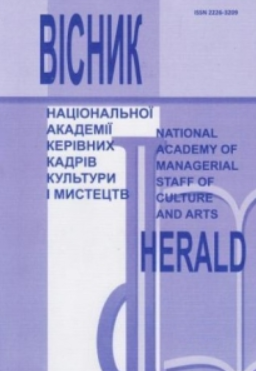К. ОРФ. СЦЕНІЧНА КАНТАТА «CARMINA BURANA»: ГРОТЕСК ЯК ЗАСІБ СТВОРЕННЯ ХУДОЖНЬОГО ОБРАЗУ СМАЖЕНОГО ЛЕБЕДЯ
C. ORFF. STAGE CANTATA «CARMINA BURANA»: GROTESQUE AS A MEANS OF CREATING AN ARTISTIC IMAGE OF THE FRIED SWAN
Author(s): Mykhailo Petrovich TyshchenkoSubject(s): Cultural history, Music, Interwar Period (1920 - 1939), History of Art
Published by: Національна академія керівних кадрів культури і мистецтв
Keywords: Art Nouveau; works of K. Orff; stage cantata "Carmina Burana"; grotesque; artistic image of the Fried Swan;
Summary/Abstract: The purpose of the article is to analyze the image of the Fried Swan from the stage cantata of Carl Orff "Carmina Burana" through the category of grotesque - the worldview principle in the culture of the Middle Ages and one of the leading types of artistic imagery in art nouveau. The paper reviews literary and musicological research on the grotesque as an aesthetic category and its application as a method of revealing the artistic image. What is being analyzed: the aesthetics of vagrant poetry, which is the basis of the libretto of Karl Orff's stage cantata; traditions of interpretation of the image of a swan in mythology, folk culture, folklore of different peoples of Europe, Christianity, literature of the Middle Ages, the Renaissance and the New Age, in particular in Romanticism, as well as in the fine arts; features of Latin poetry in general and "Swan Song" from the poetry of vagrants in particular; application of alliteration; a variant of translation into Ukrainian is provided, which is intended for a more accurate understanding of the essence of the image, reveals its new facets and is addressed to the performers of the Fried Swan part in the preparatory period of work on the image, as well as listeners. The image of the Fried Swan is the embodiment of "grotesque realism" (A. Gurevich) of the Middle Ages. The methodology is based on the application of a holistic musicological analysis, which includes philosophical-aesthetic, literary-linguistic and musical-theoretical levels. The scientific novelty of the work lies in the application of the grotesque as a philosophical and aesthetic category for studying, in particular, one of the most original images of K. Orff's work and the concept of modern musical theater in general. Therefore, the artistic and aesthetic interpretation of the figurative sphere of the cantata is considered relevant, and this work is the first such attempt in Ukrainian musicology. Conclusions. The image of the Fried Swan embodies the grotesque, in which the high and the low, the believable and the unreal, the tragic and the comic, coexist. It reflects the mentality of the Middle Ages as a unity of antinomies and at the same time possesses the characteristic features of the culture of art nouveau, where the grotesque is a typical tool for perceiving reality. The image of the Fried Swan can be considered as a kind of "key" for understanding two "artistic mentality" at once - of the Middle Ages and of the Art Nouveau.
Journal: Вісник Національної академії керівних кадрів культури і мистецтв
- Issue Year: 2021
- Issue No: 2
- Page Range: 267-272
- Page Count: 6
- Language: Ukrainian

